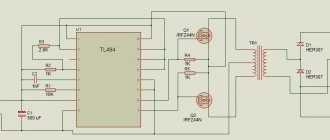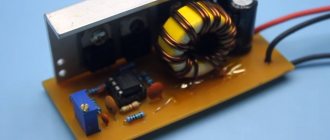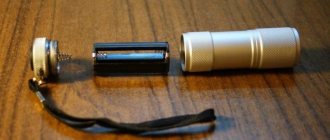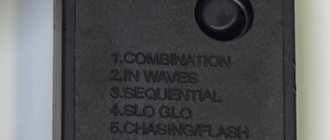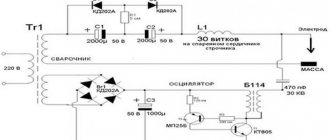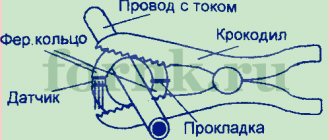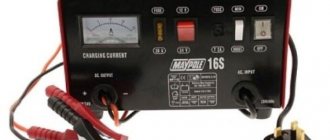Catalog
Category: Rechargeable batteries
Many PC users have old UPSs that have expired. A common cause of disability is battery failure. Since replacing with new batteries is unprofitable, and sometimes simply impossible due to the lack of analogues, these devices are simply lying around idle or thrown into the trash.
But you can give a second life to the UPS by making it a very useful device - an inverter that converts 12V in the car’s on-board network into the 220V required for some devices. Despite the fact that the factory version of the inverter will cost a lot of money, this way you will save money and make the right thing out of trash.
Removing batteries
So, the first thing to do is remove the old, leaking batteries. They can be easily dismantled by removing the bottom cover and disconnecting the power wires. If there are traces of leaked electrolyte, clean the case from oxidation crystals.
This operation will ensure the elimination of further acid leakage and will also significantly lighten the weight of the apparatus.
Uninterruptible power supply as an inverter, how to make an inverter from an uninterruptible power supply
25.03.2016
Often there is a need to obtain mains voltage (220 Volts) from a battery. This problem is faced by summer residents (in non-electrified houses) and lovers of car picnics. To solve this problem, it is recommended to use an inverter. In this case, it is a device that converts direct voltage (12 Volts) into alternating voltage (220 Volts). You can buy such a device in a store, or make it yourself, from an uninterruptible power supply with a faulty battery.
Operating principle of the inverter
The operating principle of the inverter is based on converting a constant electrical signal into a pulse signal. It is then raised to the required level by a pulse transformer. A positive quality of the inverter is the presence of feedback, that is, the pulse conversion controller (PWM controller) monitors the output voltage. With this circuit design, the output voltage remains stable, even when the battery is partially discharged.
Whatever principle the uninterruptible power supply unit is built on, the inverter is its indispensable element. Before starting work, you should clarify (by reading on the Internet) which category the uninterruptible power supply belongs to. There are several categories of UPS: “Off-Line”, “Line-Interactive” and “On-Line”, with delta conversion, ferroresonant, etc. But the first three are most widespread. The individual characteristics of the sources depend on the brand of uninterruptible power supply.
Please note that the power of the connected load should not exceed the power indicated on the device body, as this may lead to failure of the inverter.
If the uninterruptible power supply is manufactured using On-Line technology, the processor may not allow the startup of a device disconnected from the network. Or the new battery may not be detected correctly. In both cases, you will have to study the circuit diagram of the device.
First you need to decide on the choice of battery. Its voltage should not differ from the voltage of the factory UPS battery by more than 2 Volts. The main characteristics of any type of battery are its voltage and capacity.
Capacity is the ability of a battery to store electrical energy. It is measured in ampere hours. For example, a battery theoretically has a capacity of 20 amp hours, which means it can power a 1 amp load for 20 hours. In practice, there are many factors that reduce the backup time, ranging from self-discharge to aging factor. Therefore, before choosing a battery, you should determine the maximum current consumed by the load and add 20-25% of the reserve.
To carry out work on remaking an uninterruptible power supply unit, you must have average knowledge in electronics (electrical engineering) and be able to use a tool for installing electronic circuits.
When working, you will need to have: a soldering iron (40 Watt), a multimeter, alcohol-rosin paste (rosin), solder (POS-60), mounting wire, knife, pliers, wire cutters and a set of screwdrivers for disassembling the UPS case. You also need a schematic diagram of the UPS (it can be easily found on the Internet).
Schematic diagram
In the simplest case, in the “Off-Line” and “Line-Interactive” categories, the output relay is installed according to the minimum voltage circuit.
That is, if there is mains voltage, the relay pulls up and disconnects the inverter from the device output. In the new version, instead of the “K 1. 1” contacts, a toggle switch should be installed that opens the circuit. The toggle switch must have a switching current no less than the current consumed by the inverter under load.
To connect a new battery, you must disassemble the UPS case. Unsolder the old connecting wires for connecting the battery from the board and solder new ones (of the required length). After this, assemble the body.
When installing the inverter in a car, if there is free space, you can install the board in any free space (protected from moisture and dust). The power switch is displayed in a location convenient for the user.
Changing the connection diagram
Uninterruptible power supplies differ in design, but their operating principle is the same - converting 12 V to 220 V. That is, each model contains a board with an electronic voltage converter. That's what we need. But there is one condition: it must be working.
Since the devices that will be connected to this device have a standard 220 V plug, it is necessary to install a regular household socket for hidden wiring on the side or rear panel. It is to this that we solder the output wires from the 220 V converter, which previously fit into special three-arm plugs on the back panel of the UPS.
Next you need to make an input for 12 V. There are two options for this: solder a cord with a cigarette lighter connector or solder wires with alligator clips to connect directly to the battery.
In the first and second cases, the wires are soldered to those that went to the UPS battery. It is very important to maintain the polarity of the connection. The red wire is positive and the black wire is negative.
Both in the car network and in the UPS, these colors must match. It is best, of course, to check the polarity with a multimeter to be sure.
This connection scheme provides for immediate operation of the device when it is connected. If you want to turn it on via a toggle switch or machine, then simply break the “plus” in the wire coming from the car’s battery and connect one wire to the input and the other to the output of the machine attached to the UPS housing. This cuts off the power to the inverter when needed.
Inverter from uninterruptible power supply
In everyday life, sometimes there is an urgent need for uninterrupted power supply to various devices. This could be emergency lighting, incubators, aquarium equipment, or a simple amplifier with which the company went outdoors.
Modern budget computer uninterruptible power supplies can operate for no more than half an hour from autonomous power supply, and those that can and are specifically designed for this cost completely different money. Car inverters do not always output a frequency of 50 Hz.
If you need autonomy for several hours, then the thought immediately comes to mind whether it is possible to power the UPS from an ordinary car battery. We will try to answer this question today; we will make an inverter from a UPS with our own hands.
To convert it into an inverter, we chose the UPS Mustek Power Must 800 USB (board number 098-17615-00-S1 ), this UPS seemed designed to be converted, especially since a load of 500 W for household purposes is not so small.
Converting a UPS for a car battery will be divided into several stages:
- Disabling Green Power
- Installing an active cooling system
- Real tests
Green Power in UPS is some kind of tricky feature that prevents the uninterruptible power supply from working on battery power for a long time. In different devices it manifests itself and is implemented differently, in some it turns off the UPS, which works without load after 5-10 minutes, in other devices Green Power does not allow the UPS to work for more than 25-30 minutes, regardless of its load. Sometimes this function can be disabled using a special resistor, but it happens that the shutdown process is hardwired into the UPS microcontroller, and there is nothing much you can do to help it.
First of all, we open the case and take a photo of its insides for ourselves, this must be done so that in the future there will be no questions about what and where to connect during reassembly.
Then we disconnect all the wires and take out the control board, board number 098-17615-00-S1 .
If you take a closer look at the board, you can see that there are tables on it that change the operating modes of the uninterruptible power supply.
We are interested in resistor R15A , which is responsible for the Green Power . We carefully unsolder the resistor from the board, and for those who like silence, you can still make small manipulations with the buzzer. If you want to completely get rid of the squeaks that the UPS makes, you can unsolder the JP82 or remove the buzzer itself, and for those who want to muffle the sound, just solder in a small 100-300 Ohm instead of this jumper.
The next step will be to install 80mm fan and minor modifications to the UPS case.
The fan attaches perfectly to the plastic jumpers that are already inside the case.
As you can see, the fan is placed in the center of the case, which makes it possible to blow air not only on the transformer, but also on the transistor radiators located in the upper part of the case.
You can come up with a lot of ways to power the fan in the UPS. But we chose the simplest and easiest to repeat. The fan can be powered from the front panel board, which contains the power button and LEDs. Set the power button to the off position. and use a tester to ring the connector pins, find where the plus and minus from the battery come (for us this is the pin: pin 7 is plus, 5 is minus).
Already along the track or using a tester, we trace the plus of the battery to the power button and after the button (it returns through pin 8 to the board). This means that the fan power can be taken from the terminals: 5 – minus ; 8 – plus .
With this switch on, the fan will work at full power when the power button is turned on, i.e. both when operating from the network (charging) and when operating from the battery.
How to convert an uninterruptible power supply into a 12/220 V voltage converter
A voltage converter (inverter) converts 12-volt direct current into alternating current, simultaneously increasing the voltage to 220 volts. The average cost of such a device is 60-70 US dollars. However, even owners of worn-out uninterruptible power supplies with a battery start function have a very real chance of getting a working converter for virtually nothing. To do this you need to do the following:
- Open the UPS case.
- Dismantle the battery by removing two wires from the storage terminals - red (to positive) and black (to negative).
- Remove the speaker - a sound signaling device similar to a centimeter washer.
- Solder a fuse to the red wire. Most designers recommend using 5 amp fuses.
- Connect the fuse to the “input” contact of the UPS - the socket where the cable connecting the uninterruptible power supply to the socket was inserted.
- Connect the black wire to the free contact of the “input” socket.
- Take a standard cable to connect the UPS to the outlet and cut off the plug. Connect the connector to the input socket and determine the wire colors corresponding to the red and black contacts.
- Connect the wire from the red contact to the positive of the battery, and from the black to the negative.
- Turn on the UPS.
Eaton 5P 1150i UPS internals
This transformation is allowed only by uninterruptible power supplies with a battery start function. That is, the UPS must initially be able to turn on from the battery, without connecting to an outlet.
If the UPS has a standard outlet, 220 volts can be removed from its contacts. If there is no such outlet, it will be replaced by an extension cord connected to the “output” socket of the uninterruptible power supply. The extension plug is removed, after which the wires are soldered to the contacts of the “output” socket.
The main disadvantages of such converters
:
- The recommended operating time for such an inverter is up to 20 minutes, since UPSs are not designed for long-term battery operation. However, this drawback can be eliminated by embedding a computer fan operating from 12 V into the UPS case.
- Lack of battery charge controller. The user will have to periodically check the voltage at the drive terminals. To eliminate this drawback, you can embed a regular automotive relay into the design of the converter by soldering the red wire behind the fuse to pin 87. If connected correctly, such a relay will turn off the power supply when the battery voltage drops below 12 volts.
